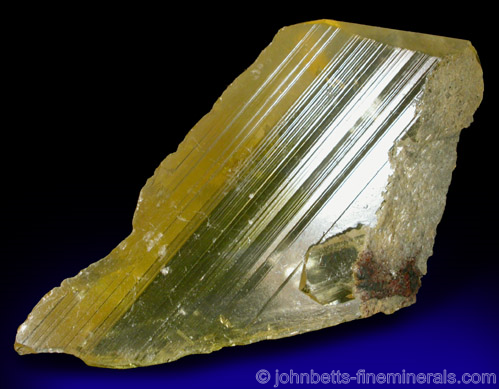The Mineral anglesite

Anglesite is a secondary lead mineral that always forms through the alteration of lead sulfides, primarily Galena. Anglesite crystals may contain impurities of Galena, giving a specimen a gray to black color. In some localities, Anglesite forms as a pseudomorph after Galena, giving the crystals a false isometric form.
Gray and black banding is present in some massive Anglesite specimens, which can be seen when a specimen is polished or sliced. Such specimens may even contain unaltered Galena in the center, which did not change over to Anglesite when the outer layers altered. An amber-red Anglesite from Touissit, Morocco, has been synthetically colored by immersing light yellow crystals in bleach.
Anglesite is named for its
type locality at the Parys Mine, on the Island of Anglesey, Wales, in the United Kingdom.
Color
Colorless, white, yellow, brown, green, orange, red, gray. May also be black from Galena impurities, which can also cause it to be banded gray and black. Sometimes multicolored with yellow and white or colorless zoning.
Crystal System
Orthorhombic
Uses
Anglesite is an ore of lead, although good crystals are preserved when possible, due to the high demand and cost of good specimens.
Noteworthy Localities
Very large Anglesite crystals were found in Tsumeb, Namibia; and some of the finest gemmy crystals came from both Mibladen and Touissit, Morocco, including the bright golden-yellow type. Other well-known localities are the Monteponi and Montevecchio Mines, Sardinia, Italy; and Broken Hill, New South Wales, Australia. The original locality of Anglesite, after which this mineral is named for, is Parys Mountain, Amlwch, on the Isle of Anglesey in Wales, United Kingdom. Specimens from
this mine are very old and are considered exceptional classics.
Three Mexican Anglesite occurrences of note are the Ahumada Mine, Sierra de Los Lamentos, Chihuahua; the Santa Eulalia District, Chihuahua; and San Felipe, Aconchi, Sonora.
In the U.S., white crystals associated with Pyromorphite have come from the Wheatley Mines in Phoenixville, Chester Co., Pennsylvania. The area of Joplin, Ottawa Co., Missouri has produced isometric pseudomorphs of Anglesite over Galena, as well as banded Anglesite. This mineral has also come from the Coeur d'Alene District, Kellogg, Shoshone Co., Idaho; the Blanchard Mine, Bingham, Socorro Co., New Mexico; the Mammoth-Saint Anthony Mine, Tiger, Pinal Co., Arizona; and Castle Dome, Yuma Co, Arizona.
Distingushing Similar Minerals
Celestine - Lacks adamantine luster, lighter in weight.
Barite - Lacks adamantine luster.
Cerussite - Effervesces in hydrochloric acid, crystals frequently twinned.
Phosgenite - May be difficult to distinguish, but occurs in different crystals, and is sectile and nonbrittle.